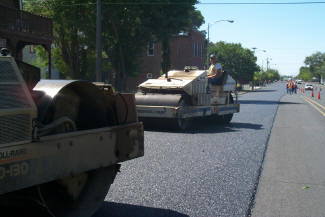
Non-structural overlays (Figure 1) do not involve extensive structural design and generally contribute little, if anything, to a pavement’s structural capacity. Non-structural overlays are generally thin surface overlays on the order of 12.5 mm (0.5 in.) to 37.5 mm (1.5 in.) that are used to (NAPA, 1995[1]):
- Improve ride quality.
- Correct minor surface defects.
- Improve safety characteristics such as skid resistance and drainage.
- Enhance appearance.
- Reduce road-tire noise.
Categories
Non-structural overlays can vary widely in composition depending upon local practice, traffic and general purpose. A loose classification of non-structural overlays follows (NAPA, 1995[1]):
- Light volume/residential traffic. The primary objective in light traffic areas is to retard asphalt binder aging of the underlying pavement. Since heavy traffic loads are not of great concern, overlays are generally less stiff (resulting in a more workable mix, increased durability and flexibility and a potential for the overlay to reheal under traffic) and use smaller-sized aggregates.
- Heavy, high-speed traffic. The primary objective in heavy, high-speed traffic areas is to prevent rutting and provide good friction. Because of this, overlays typically use larger angular aggregate and more durable mixes such as SMA or OGFC.
Construction Notes
Non-structural overlays are generally quite thin. This results in several construction concerns (NAPA, 1995[1]):
- Thin lifts require less HMA per foot of road length than thick lifts. This can result in high paver speeds (in excess of 21 m (70 ft.) per minute). Compaction may not be able to keep pace with these high speeds.
- Thin lifts will cool quicker than thick lifts. This can result in little time available for compaction before the thin overlay reaches cessation temperature (sometimes as little as 3 to 5 minutes). Therefore, roller variables should be set to account for this (e.g., enough rollers and an adequate roller pattern to compact the material before it reaches cessation temperature).
- Thin lift construction produces greater screed wear. If the lift depth is less than about twice the maximum aggregate size, the HMA may tear under the paver screed. Very thin lifts (less than 25 mm (1 inch)) can be damaged by the screed dragging large particles.
- Thin lifts are more sensitive to vibratory rolling. Incorrectly chosen amplitude, frequency or roller speed can result in aggregate degradation (i.e. breaking) and damage of the bond between the overlay and the existing pavement.
- Density control is difficult. Thin lifts provide fewer options for aggregate particles to rearrange under compaction. Thus, mat densities will tend to be less uniform than those associated with a thicker lift. This should be recognized if pay is in any way tied to mat density.
In general, compaction is more difficult and more variable on thin lifts.
Footnotes (↵ returns to text)
- National Asphalt Pavement Association (NAPA). (1995). Thin Hot Mix Asphalt Surfacings, Informational Series 110. National Asphalt Pavement Association. Lanham, MD.↵
